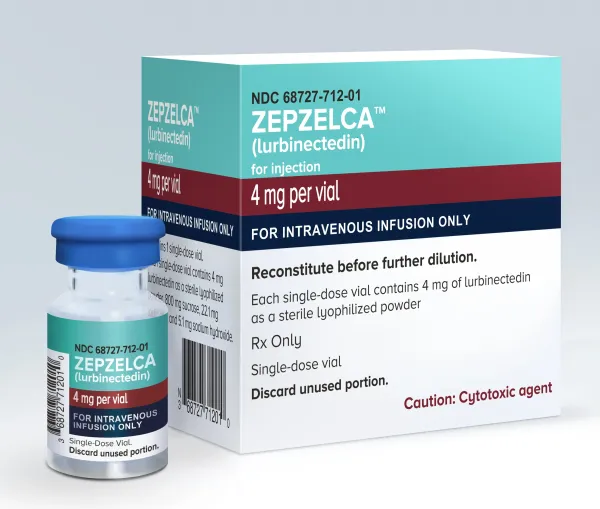Lurbinectedin Dosage
Medically reviewed by Drugs.com. Last updated on Aug 15, 2025.
Applies to the following strengths: 4 mg
Usual Adult Dose for:
Additional dosage information:
Usual Adult Dose for Small Cell Lung Cancer
3.2 mg/m2 intravenously over 60 minutes every 21 days
Duration of therapy: Until disease progression or unacceptable toxicity
Comments:
- Initiate this drug only if absolute neutrophil count (ANC) is at least 1500 cells/mm(3) and platelet count is at least 100,000/mm(3).
- Consider administering pre-infusion medications for antiemetic prophylaxis:
- Corticosteroids (dexamethasone 8 mg IV or equivalent)
- Serotonin antagonists (ondansetron 8 mg IV or equivalent)
Use: For the treatment of patients with metastatic small cell lung cancer with disease progression on or after platinum-based chemotherapy
Renal Dose Adjustments
Data not available
Liver Dose Adjustments
- Mild Liver Dysfunction (total bilirubin [TB] less than or equal to upper limit of normal [ULN] and AST greater than ULN or TB between 1 to 1.5 times ULN and any AST): No dose adjustment recommended
- Moderate to Severe Liver Dysfunction (TB greater than 1.5 times ULN and any AST): Data not available
Dose Modification for Patients who experience Hepatoxicity while in therapy:
- Grade 2: Withhold therapy until resolved to Grade 1 or less; resume therapy at the same dose.
- Grade 3 or greater: Withhold therapy until resolved to Grade 1 or less; resume at a reduced dose or permanently discontinue.
Dose Adjustments
Permanently discontinue this drug in patients who are unable to tolerate 2 mg/m2 or require a dose delay greater than 2 weeks.
Recommended Dose Reduction for Adverse Reactions:
- First dose reduction: 2.6 mg/m2 IV over 60 minutes every 21 days
- Second dose reduction: 2 mg/m2 IV over 60 minutes every 21 days
Dose Modification for Adverse Reactions:
NEUTROPENIA:
- Grade 4 or any grade febrile neutropenia: Withhold therapy until resolved to Grade 1 or less; resume therapy at a reduced dose.
- Patients with isolated Grade 4 neutropenia (neutrophil count less than 500 cells/mm(3) may receive G-CSF prophylaxis rather than undergo dose reduction.
THROMBOCYTOPENIA:
- Grade 3 with bleeding or Grade 4: Withhold therapy until platelet count is 100,000/mm(3) or greater; resume therapy at a reduced dose.
RHABDOMYOLYSIS:
- Grade 2: Withhold therapy until resolved to Grade 1 or less; resume therapy at the same dose.
- Grade 3 or greater: Permanently discontinue therapy
OTHER ADVERSE REACTIONS:
- Grade 2: Withhold therapy until resolved to Grade 1 or less; resume therapy at the same dose.
- Grade 3 or greater: Withhold therapy until resolved to Grade 1 or less; resume at a reduced dose or permanently discontinue.
Dose Modification for Concomitant Use with Strong CYP450 3A Inhibitors
- Avoid coadministration with strong CYP450 3A inhibitors.
- If coadministration cannot be avoided, reduce the dose of this drug by 50%.
- After discontinuation of strong CYP450 3A inhibitor for 5 half-lives, increase the dose of this drug to the dose used before starting.
Precautions
CONTRAINDICATIONS: None
Safety and efficacy have not been established in patients younger than 18 years.
Consult WARNINGS section for additional precautions.
Dialysis
Data not available
Other Comments
Administration advice:
- For IV use only
- Inspect for particulate matter and discoloration before administration, and do not administer if observed.
- This drug can be administered with or without an in-line filter. Polyethersulfone in-line filters with pore size of 0.22 micron are recommended if in-line filters are used.
- Consider the use of a central venous catheter, especially in patients with limited venous access to reduce the risk of extravasation.
Storage requirements:
- This drug is a hazardous drug. Follow applicable special handling and disposal procedures.
- If not used immediately after reconstitution or dilution, this solution can be stored in the refrigerator at 2C to 8C (36F to 46F) or at room temperature/ambient light, prior to administration for up to 24 hours.
- Store vials in the refrigerator at 2C to 8C (36F to 46F).
Reconstitution/preparation techniques:
- The manufacturer's product information should be consulted.
IV compatibility:
- The manufacturer's product information should be consulted.
- This drug should not be co-administered with other IV drugs concurrently within the same IV line.
Monitoring:
- Hepatic: Liver function (prior to and during therapy)
- Hematologic: Blood counts (prior to and during therapy as indicated)
- Musculoskeletal: Creatine phosphokinase (prior to and periodically during therapy)
- Reproductive (for females of reproductive potential): Pregnancy test (prior to therapy)
Patient advice:
- Read the FDA-approved patient labeling (Patient Information )
- Inform your healthcare provider of all medications, herbal and dietary supplements.
- Avoid grapefruit products and Seville oranges during treatment with this drug.
- Contact your healthcare provider immediately if you have:
- signs of infection (such as fever), unusual bruising, bleeding, tiredness or pallor
- nausea, vomiting, or severe abdominal pain
- redness and/or swelling at the infusion site, severe muscle weakness or pain
- Women of reproductive potential should contact their healthcare provider if they become pregnant or suspect a pregnancy.
- Women of reproductive potential should use effective contraception during treatment and for at least 6 months after the last dose.
- Males with female partners of reproductive potential should use effective contraception during treatment and for at least 4 months after the last dose.
- Breastfeeding is not recommended during treatment and for at least 2 weeks after the last dose.
More about lurbinectedin
- Check interactions
- Compare alternatives
- Side effects
- During pregnancy
- Drug class: alkylating agents
- En español
Patient resources
Other brands
Professional resources
Other brands
Related treatment guides
See also:
Further information
Always consult your healthcare provider to ensure the information displayed on this page applies to your personal circumstances.


